Native American Burial Grounds
Index of Native American Burial Grounds in Porter County . . . .
Numerous Native American burial grounds have been identified in Porter County.
The burial customs of Native Americans have varied widely, not only geographically,
but also through time. Differing environments, social structure, and spiritual
beliefs led to various burial practices. In the region surrounding and including
Porter County, the common Native American burial practice included the construction of earthen
mounds, some of which were chambered mounds and others that were crematory
mounds. Several prominent Native American burial mounds once existed in Porter
County; it has been reported that a total of at least 42 Native American mounds
existed at one time in Porter County. Most of these mounds have been leveled due to farming practices, development, and
destruction from early archaeological digs and curiosity seekers.
Below is an enumeration, listed alphabetically by township, of known Native American burial grounds located within the boundaries Porter County. It should be noted that not all mounds were constructed and used by Native Americans as burial tombs. For instance, piles of earth were heaped into mounds for the purpose of elevating wigwams in low, wet areas. As such, we do not provide a list of all known mounds, both existing and obliterated, in the county. Rather, we review only those Native American mounds that are known to have yielded human skeletal remains upon excavation.
Below is an enumeration, listed alphabetically by township, of known Native American burial grounds located within the boundaries Porter County. It should be noted that not all mounds were constructed and used by Native Americans as burial tombs. For instance, piles of earth were heaped into mounds for the purpose of elevating wigwams in low, wet areas. As such, we do not provide a list of all known mounds, both existing and obliterated, in the county. Rather, we review only those Native American mounds that are known to have yielded human skeletal remains upon excavation.
Boone Township
A. In a history of Boone Township published
in 1936 in The Vidette-Messenger, it is reported that:
"Even today it is not uncommon to find arrow heads and stone
hatchets in Boone Township. Immediately across what is now
State Road No. 152 from Hod Morrow's house near the Kankakee
is an old Indian burial ground. J. M. Morrow recalls that together
with his brother Hod and other boys of the community he has
unearthed many arrow heads, hatchets and bones. He has a
collection of these early relics. Some of the skeletons had been
buried in a horizontal position, others in a sitting position. One
tiny grave was uncovered and was encased on clam shells but
containing no bones. This undoubtedly was the grave of an infant
whose bones were not as yet ossified. It was not an uncommon
practice for infants to be buried in hollow logs. We can well imagine
that over these burial mounds the Indian squaws blacked their
faces and cooked and ate their food as was their custom in
mourning their departed. It is small wonder when they revisited
these mounds, after they have moved westward, that they were
shocked by the fate of the sacred burial places. In a visit to the
burial ground just mentioned the writer in company with M. E.
Dinsmoore found, in a matter of a few minutes, three arrow
heads, a part of an Indian axe and several human bones. A corn
field now covers the mound."
The aforementioned burial ground is referred to in McAllister's report on the archaeology of Porter County as Site 32. McAllister places the exact location of this Native American burial site at the northwest quarter of the southwest quarter of the southwest quarter of Section 26, Township 33 North, Range 7 West. As of 2012, the site is under cultivation for agricultural purposes. With regard to this burial site, McAllister states that:
"...the Morrow family has come upon burials in the sandy elevation,
twenty rods east of the highway. A pipe is said to have been found
with one burial. It is also reported by U. H. Morrow that mussel
shells were placed with the burial, usually over the body. This was
noted a number of times in burials found in several places on the
sandy elevation. The site is now planted in corn."
B. A Native American burial ground is located upon a sandy ridge in the northeast quarter of the northeast quarter of Section 27, Township 33 North, Range 7 West, which is the land located directly southwest of the intersection of Indiana State Route 2 and US Route 231. McAllister's report on the archaeology of Porter County refers to this Native American burial site as Site 32, and states that:
"This is known generally throughout the region as an Indian
burial ground."
Today, this land contains several residential homes.
C. The Vergin Mound was a rather isolated and undisturbed mound until 1932 when J. Gilbert McAllister and his archaeological team excavated the site. The mound is named after Richard and Doshia Vergin, owners of the property on which the mound is located at the time of its scientific excavation. The mound's exact location is the southeast quarter of the northeast quarter of the southwest quarter of Section 5, Township 33 North, Range 6 West. The 50 foot diameter mound rose 4.5 feet above the surrounding elevations. Portions of five different skeletons were uncovered during excavation.
"Even today it is not uncommon to find arrow heads and stone
hatchets in Boone Township. Immediately across what is now
State Road No. 152 from Hod Morrow's house near the Kankakee
is an old Indian burial ground. J. M. Morrow recalls that together
with his brother Hod and other boys of the community he has
unearthed many arrow heads, hatchets and bones. He has a
collection of these early relics. Some of the skeletons had been
buried in a horizontal position, others in a sitting position. One
tiny grave was uncovered and was encased on clam shells but
containing no bones. This undoubtedly was the grave of an infant
whose bones were not as yet ossified. It was not an uncommon
practice for infants to be buried in hollow logs. We can well imagine
that over these burial mounds the Indian squaws blacked their
faces and cooked and ate their food as was their custom in
mourning their departed. It is small wonder when they revisited
these mounds, after they have moved westward, that they were
shocked by the fate of the sacred burial places. In a visit to the
burial ground just mentioned the writer in company with M. E.
Dinsmoore found, in a matter of a few minutes, three arrow
heads, a part of an Indian axe and several human bones. A corn
field now covers the mound."
The aforementioned burial ground is referred to in McAllister's report on the archaeology of Porter County as Site 32. McAllister places the exact location of this Native American burial site at the northwest quarter of the southwest quarter of the southwest quarter of Section 26, Township 33 North, Range 7 West. As of 2012, the site is under cultivation for agricultural purposes. With regard to this burial site, McAllister states that:
"...the Morrow family has come upon burials in the sandy elevation,
twenty rods east of the highway. A pipe is said to have been found
with one burial. It is also reported by U. H. Morrow that mussel
shells were placed with the burial, usually over the body. This was
noted a number of times in burials found in several places on the
sandy elevation. The site is now planted in corn."
B. A Native American burial ground is located upon a sandy ridge in the northeast quarter of the northeast quarter of Section 27, Township 33 North, Range 7 West, which is the land located directly southwest of the intersection of Indiana State Route 2 and US Route 231. McAllister's report on the archaeology of Porter County refers to this Native American burial site as Site 32, and states that:
"This is known generally throughout the region as an Indian
burial ground."
Today, this land contains several residential homes.
C. The Vergin Mound was a rather isolated and undisturbed mound until 1932 when J. Gilbert McAllister and his archaeological team excavated the site. The mound is named after Richard and Doshia Vergin, owners of the property on which the mound is located at the time of its scientific excavation. The mound's exact location is the southeast quarter of the northeast quarter of the southwest quarter of Section 5, Township 33 North, Range 6 West. The 50 foot diameter mound rose 4.5 feet above the surrounding elevations. Portions of five different skeletons were uncovered during excavation.
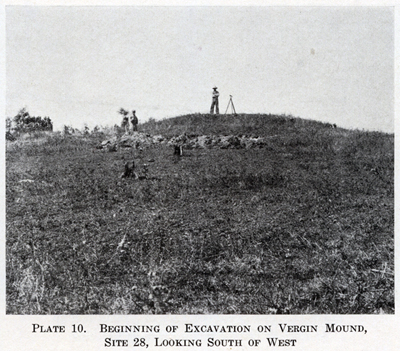
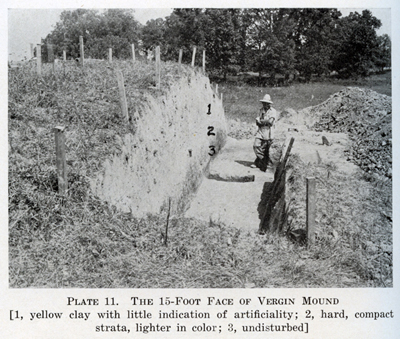
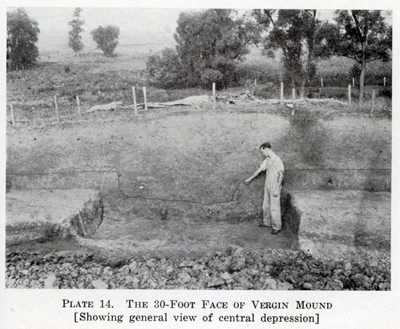
D. The Aylesworth Mound is named after the Aylesworth family since it was
located on their property when the mound was first scientifically evaluated. The
mound is located in the northwest quarter of the southeast quarter of the
southeast quarter of Section 9, Township 33 North, Range 6 West, approximately
1,300 feet north of Indiana State Road 8 and 1,000 feet west of County Road 200
West. Today, the cul-de-sacs of Walter Drive and Chester Drive are located very
near the location of the Aylesworth Mound. The mound was excavated as early as
1891 by George C. Gregg, of Hebron, who found skeletal material at a depth of
three feet. No artifacts were found with the human remains.
E. In McAllister's archaeological report of Porter County is mentioned a burial ground on the property of John Reif. The location of the burial ground is the northwest quarter of the northeast quarter of the northwest quarter of Section 17, Township 33 North, Range 5 West. Today, the burial site is situated between Indiana State Road 8 and Reif Drive, within a subdivision of homes. McAllister states that:
"Tradition among the oldest settlers tells of a natural sand mound
which has been used as an Indian cemetery. According to John
Reif white men are buried on the southern slope of this same
elevation. Artifacts are sometimes unearthed while plowing....About
100 feet north and on the line between Sections 17 and 8, skeletons
and accompanying artifacts were unearthed when a cut was put
through the sand ridge in building the highway."
F. In Lewis Publishing Company's 1912 published history of Porter County a large Native American burial ground is mentioned to exist in Section 21, Township 33 North, Range 6 West:
"In the early '50s [1850s] a sawmill was set up near the mouth of Sandy
Hook creek in Boone township, and soon after that it was started a
number of old Indians visited the neighborhood to pay their respects to
the graves of some of their ancestors. This led to the discovery of an
old Indian burying ground some seven or eight acres in extent, located
in section 21, township 33 north, range 6 west, a short distance north of
the Kankakee river. After the departure of the Indian visitors, excavations
were made and a number of implements, weapons, ornaments, images,
etc., were found."
Source Citations:
Anonymous. August 18, 1936. "The Hebron School History of Boone
Township: As Compiled by History Class and Instructors for
The Vidette-Messenger," The Vidette-Messenger Volume 10,
Section 3, pp. 21-23.
Blatchley, W. S. 1898. "The Geology of Lake and Porter Counties, Indiana,"
(pp. 25-104) In: Indiana Department of Geology and Natural
Resources, 22nd Annual Report. Indianapolis, Indiana: William B.
Buford. 1,197 p. [see p. 52]
Lewis Publishing Company. 1912. History of Porter County, Indiana: A
Narrative of its Historical Progress, its People and its Principal
Interests. Volume I. Chicago, Illinois: Lewis Publishing Company.
357 p. [see p. 24]
McAllister, J. Gilbert. 1932. The Archaeology of Porter County. Indiana
History Bulletin 10(1):1-96.
E. In McAllister's archaeological report of Porter County is mentioned a burial ground on the property of John Reif. The location of the burial ground is the northwest quarter of the northeast quarter of the northwest quarter of Section 17, Township 33 North, Range 5 West. Today, the burial site is situated between Indiana State Road 8 and Reif Drive, within a subdivision of homes. McAllister states that:
"Tradition among the oldest settlers tells of a natural sand mound
which has been used as an Indian cemetery. According to John
Reif white men are buried on the southern slope of this same
elevation. Artifacts are sometimes unearthed while plowing....About
100 feet north and on the line between Sections 17 and 8, skeletons
and accompanying artifacts were unearthed when a cut was put
through the sand ridge in building the highway."
F. In Lewis Publishing Company's 1912 published history of Porter County a large Native American burial ground is mentioned to exist in Section 21, Township 33 North, Range 6 West:
"In the early '50s [1850s] a sawmill was set up near the mouth of Sandy
Hook creek in Boone township, and soon after that it was started a
number of old Indians visited the neighborhood to pay their respects to
the graves of some of their ancestors. This led to the discovery of an
old Indian burying ground some seven or eight acres in extent, located
in section 21, township 33 north, range 6 west, a short distance north of
the Kankakee river. After the departure of the Indian visitors, excavations
were made and a number of implements, weapons, ornaments, images,
etc., were found."
Source Citations:
Anonymous. August 18, 1936. "The Hebron School History of Boone
Township: As Compiled by History Class and Instructors for
The Vidette-Messenger," The Vidette-Messenger Volume 10,
Section 3, pp. 21-23.
Blatchley, W. S. 1898. "The Geology of Lake and Porter Counties, Indiana,"
(pp. 25-104) In: Indiana Department of Geology and Natural
Resources, 22nd Annual Report. Indianapolis, Indiana: William B.
Buford. 1,197 p. [see p. 52]
Lewis Publishing Company. 1912. History of Porter County, Indiana: A
Narrative of its Historical Progress, its People and its Principal
Interests. Volume I. Chicago, Illinois: Lewis Publishing Company.
357 p. [see p. 24]
McAllister, J. Gilbert. 1932. The Archaeology of Porter County. Indiana
History Bulletin 10(1):1-96.
Liberty Township
A. A Native American burial ground reportedly existed
adjacent to the The Cole Cemetery. The Cole Cemetery, which no longer exists, was located on the southwest
quarter of Section 19, west of the Old 49 Highway. The cemetery was situated on
a hill just behind the Cole family farm, now occupied by the Liberty Bible
Church. After the death of Sally (Dillingham) Cole, the Cole farm was sold and
then resold to I. M. Biggs around 1900.
The Biggs family requested that the graves be moved from the site, which the Cole family agreed to do since they feared that the tombstones would be removed and the graves plowed over and obliterated. The graves and tombstones of four Cole family members buried in the cemetery were disinterred and moved to the Adams Cemetery in Morgan Township, where Sally (Dillingham) Cole's son had a family plot.
Source Citation:
Communication with J. Timothy Cole of Chesterton, Indiana.
The Biggs family requested that the graves be moved from the site, which the Cole family agreed to do since they feared that the tombstones would be removed and the graves plowed over and obliterated. The graves and tombstones of four Cole family members buried in the cemetery were disinterred and moved to the Adams Cemetery in Morgan Township, where Sally (Dillingham) Cole's son had a family plot.
Source Citation:
Communication with J. Timothy Cole of Chesterton, Indiana.
Morgan Township
A. The LaCount Mound is located in the northeast
quarter of the southwest quarter of the southwest quarter of Section 30,
Township 34 North, Range 5 West in Morgan Township, approximately 400 feet north
of Sandy Hook Creek. The name of the mound originates from the owner of the land
on which it is located, Charles F. LaCount. The mound is reported to have been
approximately 15 feet in height, but by 1932 the height of the mound had
diminished to 5 feet due to previous excavations. Today, the mound is virtually
flattened. Just west of the center of the mound at a depth of three to four feet
were found three skeletons. A leather-wrapped copper celt measuring 5.63 inches
in length, a pipe, and a piece of pottery were found with the skeletal remains.
An article published in the August 29, 1921, issue of the Valparaiso Daily Vidette states that:
"An Indian mound, on the Charles LaCount farm, in Morgan
township, which has been excavated by the LaCount Brothers,
has given up four skeletons of what are generally believed
to be Indians. The bones of the bodies crumble upon being
exposed to the air, but the teeth are remarkably well preserved.
The skeletons are those of big men, and tomahawks, pipes
and pottery found near the bodies prove beyond a doubt that
they are Indians. The state of the bones indicates that burial
took place many years ago. The mound itself, is twenty feet
high and more than fifty feet across. The earth composing the
mound is clay texture of soil that is proof against weathering.
There are three other mounds on the LaCount farm and these
will be excavated by the LaCount boys."
In 1921, Charles F. LaCount owned the majority of the south one-half of Section 30 in Morgan Township.
Source Citation:
McAllister, J. Gilbert. 1932. The Archaeology of Porter County. Indiana
History Bulletin 10(1):1-96.
An article published in the August 29, 1921, issue of the Valparaiso Daily Vidette states that:
"An Indian mound, on the Charles LaCount farm, in Morgan
township, which has been excavated by the LaCount Brothers,
has given up four skeletons of what are generally believed
to be Indians. The bones of the bodies crumble upon being
exposed to the air, but the teeth are remarkably well preserved.
The skeletons are those of big men, and tomahawks, pipes
and pottery found near the bodies prove beyond a doubt that
they are Indians. The state of the bones indicates that burial
took place many years ago. The mound itself, is twenty feet
high and more than fifty feet across. The earth composing the
mound is clay texture of soil that is proof against weathering.
There are three other mounds on the LaCount farm and these
will be excavated by the LaCount boys."
In 1921, Charles F. LaCount owned the majority of the south one-half of Section 30 in Morgan Township.
Source Citation:
McAllister, J. Gilbert. 1932. The Archaeology of Porter County. Indiana
History Bulletin 10(1):1-96.
Pleasant Township
A. The Weise Mound is discussed in great
detail in McAllister's report of the archaeology of Porter County. The mound
was named after Albert Weise, on whose property the mound existed when it was
scientifically examined by McAllister. The exact location of the mound is the
northeast quarter of the southeast quarter of the northeast quarter of Section
27, Township 33 North, Range 6 West. Alternatively, the land located directly
southwest of where County Road 1025 South and County Road 100 West meet is where
the Weiss Mound is located. Note that the region around the Weiss Mound was
commonly referred to as Indian Garden.
McAllister reports that the Weiss Mound was first plowed in 1925 and had been plowed two additional times between 1926 and 1932. An excavation of the mound is known to have taken place in 1908 by Charles Wilcox, who is reported to have unearthed six skeletons. During McAllister's excavation of the Weise Mound, five more skeletons were found and a group of "reburials" were also uncovered, which may possibly have been from the Wilcox excavation.
McAllister reports that the Weiss Mound was first plowed in 1925 and had been plowed two additional times between 1926 and 1932. An excavation of the mound is known to have taken place in 1908 by Charles Wilcox, who is reported to have unearthed six skeletons. During McAllister's excavation of the Weise Mound, five more skeletons were found and a group of "reburials" were also uncovered, which may possibly have been from the Wilcox excavation.
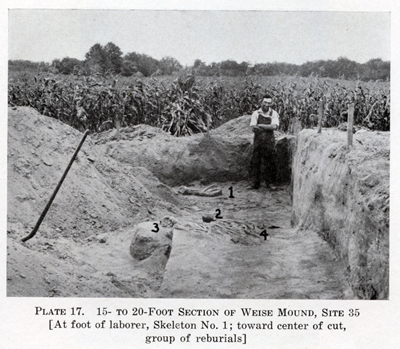
B. The Collier Burial Ground is located just east of the the historic
Collier Store at Baum's Bridge. The exact location of the burial ground is the
south one-half of the southwest quarter of the southeast quarter of Section 26,
Township 33 North, Range 6 West. A very large number of Native American
artifacts have been unearthed in this particular area over the past many
decades. In McAllister's report on the archaeology of Porter County, it is
mentioned that:
"Several burials have been found by Jim Collier in the immediate
vicinity. One, he says, was in a sitting posture."
Source Citations:
McAllister, J. Gilbert. 1932. The Archaeology of Porter County. Indiana
History Bulletin 10(1):1-96.
"Several burials have been found by Jim Collier in the immediate
vicinity. One, he says, was in a sitting posture."
Source Citations:
McAllister, J. Gilbert. 1932. The Archaeology of Porter County. Indiana
History Bulletin 10(1):1-96.
Portage Township
A. The 1882 History of Porter County, Indiana, states that (p. 215):
"On Section 36, Township 36, Range 6, was what had the
appearance of an Indian burying-ground. Evidences of
about twenty graves were to be seen."
The exact location of this burial ground in Section 36 is unknown.
Source Citation:
Goodspeed, Weston A., and Charles Blanchard. 1882. Counties of Lake
and Porter, Indiana: Historical and Biographical. Chicago, Illinois:
F. A. Battey and Company. 771 p.
"On Section 36, Township 36, Range 6, was what had the
appearance of an Indian burying-ground. Evidences of
about twenty graves were to be seen."
The exact location of this burial ground in Section 36 is unknown.
Source Citation:
Goodspeed, Weston A., and Charles Blanchard. 1882. Counties of Lake
and Porter, Indiana: Historical and Biographical. Chicago, Illinois:
F. A. Battey and Company. 771 p.
Porter Township
The Wark Mounds represent a group of at least ten Native American mounds located
in Sections 27, 28, 33, and 34 of Township 34 North, Range 6 West in Porter
Township, east of Boone Grove. This complex of mounds is named after one of the
former owners of land upon which several mounds are located, John Wark. The
largest mound in the group is referred to as the Wark Mound. These mounds were
known to exist as early as 1834 since they are clearly notated in the Record of
Field Notes, United States Land Survey; the notes regarding the survey of
the north-south line between Sections 33 and 34 state that "a large
artificial mound surrounded by a number of smaller ones." By 1932, many of
the mounds, especially those located in Section 33, were barely visible due to
previous excavations. Note that not every mound in this group has yielded
skeletal remains when excavated. Thus, only mounds that have yielded skeletal
remains are detailed below.
A. The Wark Mound is the largest Native American burial mound in Porter County and is located in the northeast quarter of the northeast quarter of the northeast quarter of Section 33, Township 34 North, Range 6 West. Being slightly more than 100 feet in diameter, the Wark Mound was approximately 16 feet in height before excavations reduced its height to about ten feet by 1932. The Record of Field Notes, United States Land Survey of 1834 reports that nine smaller mounds surrounded the Wark Mound, but by 1897 these nine smaller mounds no longer were visually perceptible. A. E. Upp was the first man to farm the land upon which the Wark Mound is located. It has been reported that Upp stated that the mound was much steeper and quite difficult to plow when he began farming the land. On October 6 and 7, 1897, State Geologist W. S. Blatchley excavated a ditch measuring three feet wide, 32 feet long, and 14 feet deep through the center of the Wark Mound. Near the very center of the mound was found one very badly decayed partial skeleton; a total of 14 teeth were found and only a few bones were recovered.
A. The Wark Mound is the largest Native American burial mound in Porter County and is located in the northeast quarter of the northeast quarter of the northeast quarter of Section 33, Township 34 North, Range 6 West. Being slightly more than 100 feet in diameter, the Wark Mound was approximately 16 feet in height before excavations reduced its height to about ten feet by 1932. The Record of Field Notes, United States Land Survey of 1834 reports that nine smaller mounds surrounded the Wark Mound, but by 1897 these nine smaller mounds no longer were visually perceptible. A. E. Upp was the first man to farm the land upon which the Wark Mound is located. It has been reported that Upp stated that the mound was much steeper and quite difficult to plow when he began farming the land. On October 6 and 7, 1897, State Geologist W. S. Blatchley excavated a ditch measuring three feet wide, 32 feet long, and 14 feet deep through the center of the Wark Mound. Near the very center of the mound was found one very badly decayed partial skeleton; a total of 14 teeth were found and only a few bones were recovered.
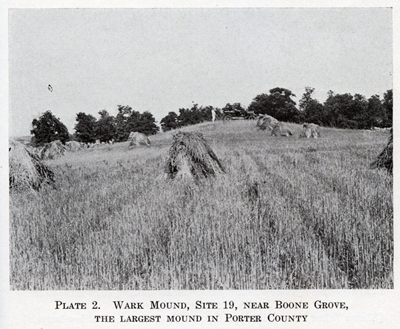
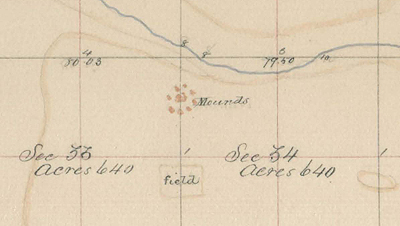
Portion of original government survey map prepared by William Clark in
1834 of Township 34 North, Range 6 West, showing the Wark Mounds
in Sections 33 and 34.
B.
The Allman Mound is one of the mounds in the Wark Mounds group and is located in
the approximate center of the south one-half of the northeast quarter of the
northwest quarter of Section 34, Township 34 North, Range 6 West. In 1931, the
diameter and height of the Allman Mound was reported to be 45 feet and 4.1 feet,
respectively. State Geologist W. S. Blatchley reported that in October of 1897,
Charles H. Wood, Superintendent of the Valparaiso Schools, excavated the Allman
Mound. Blatchley stated that Wood found "no skeletons or implements of any
kind," but that "charcoal and ashes were quite common."
In 1928, J. C. Allman excavated at the center of the mound to a depth of three
feet. Allman unearthed several skeletal remains, reporting that most of the
bones were in an excellent state of preservation.
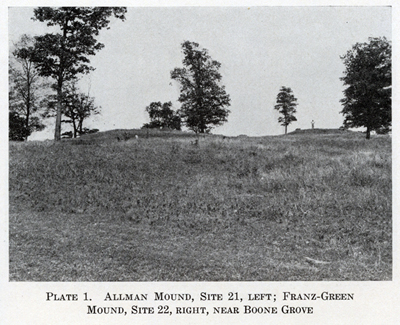
C.
The Franz-Green Mound is one of the mounds in the Wark Mounds group and is
located in the southeast quarter of the northeast quarter of the northwest
quarter of Section 34, Township 34 North, Range 6 West. State Geologist E. W.
Blatchley reported in 1897 that this mound "is 210 feet in circumference and
its crest is 10 feet above the surrounding level." Blatchley reports that
Charles H. Wood,
Superintendent of the Valparaiso Schools, excavated at the Franz-Green
Mound, but no information concerning Wood's discoveries is available. In 1915,
the mound was excavated by Harvey Franz and Amos Green, from which the mound
derives its name. The Franz-Green excavation resulted in the discovery of at
least 17 burials, three of which were children. Numerous artifacts were also
found with the burials. Interestingly, much of the soil removed from the
Franz-Green Mound was taken away to be used as fill for the low areas around the
barn yard of William Rampke.
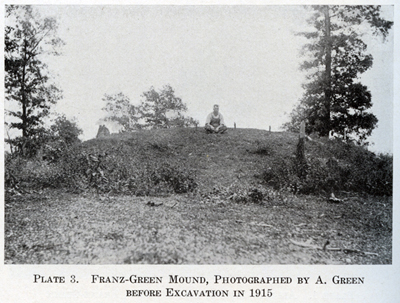
D.
Two smaller mounds, known as Site 23 in McAllister's archaeological report for
Porter County published in the Indiana History Bulletin, exist on the section line between Sections 33 and 34,
Township 34 North, Range 6 West. State Geologist W. S. Blatchley reports that
one of these two mounds "is 175 feet in circumference and six feet high, the
other 75 feet in circumference and four feet in height." Blatchley and
Charles H. Wood, Superintendent of the Valparaiso Schools, excavated at Site 23 in 1897,
though results of their excavation are unknown. In the fall of 1930, J. C. Allman
and some boy scouts excavated the larger of the two mounds located at Site 23
and at a depth of four feet discovered skeletal material. The human remains were
reportedly not disturbed.
Source Citations:
Anonymous. June 1, 1956. "Indian Burial Mounds Still Dot Landscape
in Boone Grove Area," The Vidette Messenger 29(281):8.
Blatchley, W. S. 1898. "The Geology of Lake and Porter Counties,
Indiana, " in (pp. 25-104) Indiana Department of Geology
and Natural Resources, Twenty-second Annual Report.
Indianapolis, Indiana: William B. Buford. 1,197 p. [see p. 52]
Drury, John. 1956. This is Porter County. Chicago, Illinois: Inland
Photo Company. 352 p.
Field Notes North of the Base Line and West of the 2d Meridian,
Indiana, 22:447. Located at Indiana State Archives, Indianapolis,
Indiana.
McAllister, J. Gilbert. 1932. "The Archaeology of Porter County," Indiana
History Bulletin 10(1):1-96.
The Stroller. November 10, 1960. "Bodies of 17 Warriors Found in
Battle Regalia," The Vidette-Messenger 34(110):1, 14.
Anonymous. June 1, 1956. "Indian Burial Mounds Still Dot Landscape
in Boone Grove Area," The Vidette Messenger 29(281):8.
Blatchley, W. S. 1898. "The Geology of Lake and Porter Counties,
Indiana, " in (pp. 25-104) Indiana Department of Geology
and Natural Resources, Twenty-second Annual Report.
Indianapolis, Indiana: William B. Buford. 1,197 p. [see p. 52]
Drury, John. 1956. This is Porter County. Chicago, Illinois: Inland
Photo Company. 352 p.
Field Notes North of the Base Line and West of the 2d Meridian,
Indiana, 22:447. Located at Indiana State Archives, Indianapolis,
Indiana.
McAllister, J. Gilbert. 1932. "The Archaeology of Porter County," Indiana
History Bulletin 10(1):1-96.
The Stroller. November 10, 1960. "Bodies of 17 Warriors Found in
Battle Regalia," The Vidette-Messenger 34(110):1, 14.
Washington Township
A. The 1882 History of Porter County, Indiana, states that (p. 178):
"A village of about one hundred or more Pottawatomie Indians
was situated near the present site of Prattville. Their burying-ground
was located on what is now Harmond Beach's orchard."
An inspection of the 1876 plat map for Washington Township published by A. G. Hardesty, shows that Harmond Beach's orchard, and thus the Native American burial ground, is located in the northwest quarter of the northeast quarter of the southwest quarter of Section 21, Township 35 North, Range 5 West. No evidence of the Indian burial ground exists today.
Source Citations:
Goodspeed, Weston A., and Charles Blanchard. 1882. Counties of Lake
and Porter, Indiana: Historical and Biographical. Chicago, Illinois:
F. A. Battey and Company. 771 p.
Hardesty, A. G. 1876. Illustrated Historical Atlas of Porter County,
Indiana. Valparaiso, Indiana: A. G. Hardesty. 90 p.
"A village of about one hundred or more Pottawatomie Indians
was situated near the present site of Prattville. Their burying-ground
was located on what is now Harmond Beach's orchard."
An inspection of the 1876 plat map for Washington Township published by A. G. Hardesty, shows that Harmond Beach's orchard, and thus the Native American burial ground, is located in the northwest quarter of the northeast quarter of the southwest quarter of Section 21, Township 35 North, Range 5 West. No evidence of the Indian burial ground exists today.
Source Citations:
Goodspeed, Weston A., and Charles Blanchard. 1882. Counties of Lake
and Porter, Indiana: Historical and Biographical. Chicago, Illinois:
F. A. Battey and Company. 771 p.
Hardesty, A. G. 1876. Illustrated Historical Atlas of Porter County,
Indiana. Valparaiso, Indiana: A. G. Hardesty. 90 p.
Westchester Township
A. The Bailly Cemetery is located approximately three-quarters of a mile north of
the Joseph Bailly Homestead in Westchester Township, at the base of a sand
ridge in the center of the northeast quarter of Section 27 [click
here for detailed historical information concerning Bailly Cemetery]. It is the oldest
white burial ground in Porter County. It has been recorded that Joseph Bailly buried his son,
Napoleon B. "Robert" Bailly, here in
1827. It has also been recorded that Native Americans first used the site for
the burial of their dead. Though skeletons have been uncovered at the cemetery
site on numerous occasions, they have always been reburied without a
determination of their race. Hence, it has not been conclusively determined
whether the Bailly Cemetery was originally a sacred Indian burial ground.
B. An Native American burial ground is located just to the west of the now nonexistent village of City West in the southwest quarter of the southeast quarter of the southeast quarter of the northeast quarter of Section 14, Township 37 North, Range 6 West. City West was laid out along the south-easterly shore of Lake Michigan, at, or just south of, the mouth of Fort Creek. The pavilion at Indiana Dunes State Park is located just east of where the village was located. City West competed with Michigan City for federal funds to be used for the construction of a port, but did not gain the support of Congress and slowly became depopulated. All the structures in City West were destroyed by a lightening-ignited wildfire in 1854. Timothy H. Ball, a resident of City West as a young boy, provides a firsthand account of a Native American burial ground adjacent to City West in his book concerning the history of Northwest Indiana in the 1800s:
"On a sand knoll, between the village and the lake, on the bank
of the creek, there was an Indian burial ground of some size, the
marks or inscriptions on the head-boards seeming to have been
painted with Indian puccoon root. Here the villagers did not bury;
this sacred spot they did not disturb. Near this, in the summer and
fall, some Indian encampments were held; the Indians being quiet,
peaceable hunting parties, one party at least having come down
Lake Michigan from Green Bay, if the information imparted to the
villagers was correct."
Hardesty's history of Porter County, published in 1876, also mentions the Native American burial ground located near City West:
"Old City West, an Indian barricade at the time this country was
first known to the whites, and now used as a summer resort by many,
is the oldest point in this county entitled to the name of a town. Mr.
Joseph C. Morgan was at an Indian burial at this place in 1838. It
was the funeral of a squaw, wife of the principal chief. The
ceremonies consisted of speaking, singing, dancing and a sacred
feast of well-baked venison."
McAllister's archaeological report of Porter County mentions the Native American Burial ground near City West, stating that:
"...at a place known as 'grave-yard' blow-out, a number of
people have found skeletal material, including vertebra with
arrow embedded in the bone."
C. McAllister's archaeological report of Porter County also reports the existence of a Native American burial ground located in the southwest quarter of the southeast quarter of the northeast quarter of Section 1, Township 37 North, Range 6 West, which is approximately 500 feet southwest of the entrance to St. Patrick Catholic Cemetery from South Calumet Road. McAllister's report states that:
"According to W. Lahyn [William LaHayn] and A. J. Bouser [Arthur
J. Bowser] this mound was formerly 6 feet high and 80 feet in
diameter. It is now little more than 1.5 feet high, though still
retaining much of its symmetry. It has been dug into a number
of times, skeletal material and many relics being found. The
mound has been farmed over and is now planted in alfalfa. Only
flint chips were found at the time of the present survey."
D. A Native American burial mound once stood between Morgan Lake and Billington Lake on the line between Sections 5 and 6, Township 36 North, Range 5 West. Today, the mound is completely obliterated and Sand Creek Drive traverses the site. The mound is thought to have stood about one to two hundred feet north of the north parking lot at Sand Creek Country Club. McAllister mentions this mound in his survey of archaeological sites in of Porter County:
"It was reported by Ed Morgan that there were formerly three
mounds on his father's farm. He estimates that they were
about 12 feet in diameter and approximately 2 feet high.
They were excavated by the Morgans in 1893, but only
skeletal material was found....Two slight elevations indicates
where they stood. The soil is a sandy loam. Burned stone and
flint flakes were found on the surface. Large oak trees grown
on and near the site."
E. When a Wagner Road (County Road 50 West) was being constructed to connect with the Dunes Highway (US Route 12) north of the town of Porter, seven complete skeletons were said to have been removed, though no artifacts were reported to be found with the skeletal remains. These Native American burials were found just west of Wagner Road and south of the Dunes Highway, or more specifically in the northeast corner of the northeast corner of the northwest corner of Section 26, Township 37 North, Range 6 West. The land on which the skeletal remains were found was, at the time of discovery, owned by Benjamin and Clara Lehman.
Source Citations:
Ball, Timothy H. 1900. Northwestern Indiana From 1800 to 1900: A
View of Our Region Through the Nineteenth Century. Chicago,
Illinois: Donohue & Henneberry. 570 p.
Bowers, John O. 1929. "Dream Cities of The Calumet," in (pp. 174-
198) History of Lake County. Volume 10. Gary, Indiana: Lake
County Historical Association (Calumet Press). 223 p.
Bringelson, Dawn, and Jay T. Sturdevant. 2007. An Archeological
Overview and Assessment of Indiana Dunes National
Lakeshore, Indiana. Technical Report No. 7. Lincoln,
Nebraska: US Department of the Interior, National Park
Service, Midwest Archeological Center. 160 p.
Clemenson, A. Berle, Kenneth W. Bennett, and Catherine H. Blee. 1976.
Historic Structure Report, Bailly Cemetery: Historical,
Architectural, and Archeological Data, Indiana Dunes
National Lakeshore, Indiana. United States Department of the
Interior, National Park Service, Historic Preservation Division.
Denver, Colorado: United States Department of the Interior. 85 p.
Hardesty, A. G. 1876. Illustrated Historical Atlas of Porter County,
Indiana. Valparaiso, Indiana: A. G. Hardesty. 90 p.
McAllister, J. Gilbert. 1932. "The Archaeology of Porter County," Indiana
History Bulletin 10(1):1-96.
Nelson, C. W. 1949. The Bailly Cemetery. Manuscript in Reed Folder.
Porter, Indiana: Indiana Dunes National Lakeshore Park. pp. 11-12.
Skinner, Hubert M. January 15, 1878. Complete History of Porter
County. Valparaiso, Indiana: Published by Author.
NOTE: If you have information that you like to add to this database, including corrections, then please contribute it to Steve Shook.
Native American Burial Ground data and report prepared by Steven R. Shook
B. An Native American burial ground is located just to the west of the now nonexistent village of City West in the southwest quarter of the southeast quarter of the southeast quarter of the northeast quarter of Section 14, Township 37 North, Range 6 West. City West was laid out along the south-easterly shore of Lake Michigan, at, or just south of, the mouth of Fort Creek. The pavilion at Indiana Dunes State Park is located just east of where the village was located. City West competed with Michigan City for federal funds to be used for the construction of a port, but did not gain the support of Congress and slowly became depopulated. All the structures in City West were destroyed by a lightening-ignited wildfire in 1854. Timothy H. Ball, a resident of City West as a young boy, provides a firsthand account of a Native American burial ground adjacent to City West in his book concerning the history of Northwest Indiana in the 1800s:
"On a sand knoll, between the village and the lake, on the bank
of the creek, there was an Indian burial ground of some size, the
marks or inscriptions on the head-boards seeming to have been
painted with Indian puccoon root. Here the villagers did not bury;
this sacred spot they did not disturb. Near this, in the summer and
fall, some Indian encampments were held; the Indians being quiet,
peaceable hunting parties, one party at least having come down
Lake Michigan from Green Bay, if the information imparted to the
villagers was correct."
Hardesty's history of Porter County, published in 1876, also mentions the Native American burial ground located near City West:
"Old City West, an Indian barricade at the time this country was
first known to the whites, and now used as a summer resort by many,
is the oldest point in this county entitled to the name of a town. Mr.
Joseph C. Morgan was at an Indian burial at this place in 1838. It
was the funeral of a squaw, wife of the principal chief. The
ceremonies consisted of speaking, singing, dancing and a sacred
feast of well-baked venison."
McAllister's archaeological report of Porter County mentions the Native American Burial ground near City West, stating that:
"...at a place known as 'grave-yard' blow-out, a number of
people have found skeletal material, including vertebra with
arrow embedded in the bone."
C. McAllister's archaeological report of Porter County also reports the existence of a Native American burial ground located in the southwest quarter of the southeast quarter of the northeast quarter of Section 1, Township 37 North, Range 6 West, which is approximately 500 feet southwest of the entrance to St. Patrick Catholic Cemetery from South Calumet Road. McAllister's report states that:
"According to W. Lahyn [William LaHayn] and A. J. Bouser [Arthur
J. Bowser] this mound was formerly 6 feet high and 80 feet in
diameter. It is now little more than 1.5 feet high, though still
retaining much of its symmetry. It has been dug into a number
of times, skeletal material and many relics being found. The
mound has been farmed over and is now planted in alfalfa. Only
flint chips were found at the time of the present survey."
D. A Native American burial mound once stood between Morgan Lake and Billington Lake on the line between Sections 5 and 6, Township 36 North, Range 5 West. Today, the mound is completely obliterated and Sand Creek Drive traverses the site. The mound is thought to have stood about one to two hundred feet north of the north parking lot at Sand Creek Country Club. McAllister mentions this mound in his survey of archaeological sites in of Porter County:
"It was reported by Ed Morgan that there were formerly three
mounds on his father's farm. He estimates that they were
about 12 feet in diameter and approximately 2 feet high.
They were excavated by the Morgans in 1893, but only
skeletal material was found....Two slight elevations indicates
where they stood. The soil is a sandy loam. Burned stone and
flint flakes were found on the surface. Large oak trees grown
on and near the site."
E. When a Wagner Road (County Road 50 West) was being constructed to connect with the Dunes Highway (US Route 12) north of the town of Porter, seven complete skeletons were said to have been removed, though no artifacts were reported to be found with the skeletal remains. These Native American burials were found just west of Wagner Road and south of the Dunes Highway, or more specifically in the northeast corner of the northeast corner of the northwest corner of Section 26, Township 37 North, Range 6 West. The land on which the skeletal remains were found was, at the time of discovery, owned by Benjamin and Clara Lehman.
Source Citations:
Ball, Timothy H. 1900. Northwestern Indiana From 1800 to 1900: A
View of Our Region Through the Nineteenth Century. Chicago,
Illinois: Donohue & Henneberry. 570 p.
Bowers, John O. 1929. "Dream Cities of The Calumet," in (pp. 174-
198) History of Lake County. Volume 10. Gary, Indiana: Lake
County Historical Association (Calumet Press). 223 p.
Bringelson, Dawn, and Jay T. Sturdevant. 2007. An Archeological
Overview and Assessment of Indiana Dunes National
Lakeshore, Indiana. Technical Report No. 7. Lincoln,
Nebraska: US Department of the Interior, National Park
Service, Midwest Archeological Center. 160 p.
Clemenson, A. Berle, Kenneth W. Bennett, and Catherine H. Blee. 1976.
Historic Structure Report, Bailly Cemetery: Historical,
Architectural, and Archeological Data, Indiana Dunes
National Lakeshore, Indiana. United States Department of the
Interior, National Park Service, Historic Preservation Division.
Denver, Colorado: United States Department of the Interior. 85 p.
Hardesty, A. G. 1876. Illustrated Historical Atlas of Porter County,
Indiana. Valparaiso, Indiana: A. G. Hardesty. 90 p.
McAllister, J. Gilbert. 1932. "The Archaeology of Porter County," Indiana
History Bulletin 10(1):1-96.
Nelson, C. W. 1949. The Bailly Cemetery. Manuscript in Reed Folder.
Porter, Indiana: Indiana Dunes National Lakeshore Park. pp. 11-12.
Skinner, Hubert M. January 15, 1878. Complete History of Porter
County. Valparaiso, Indiana: Published by Author.
NOTE: If you have information that you like to add to this database, including corrections, then please contribute it to Steve Shook.
Native American Burial Ground data and report prepared by Steven R. Shook
This comment has been removed by the author.
ReplyDelete